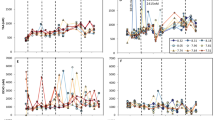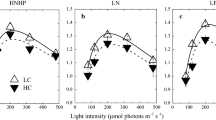Abstract
Rising atmospheric CO2 and deliberate CO2 sequestration in the ocean change seawater carbonate chemistry in a similar way, lowering seawater pH, carbonate ion concentration and carbonate saturation state and increasing dissolved CO2 concentration. These changes affect marine plankton in various ways. On the organismal level, a moderate increase in CO2 facilitates photosynthetic carbon fixation of some phytoplankton groups. It also enhances the release of dissolved carbohydrates, most notably during the decline of nutrient-limited phytoplankton blooms. A decrease in the carbonate saturation state represses biogenic calcification of the predominant marine calcifying organisms, foraminifera and coccolithophorids. On the ecosystem level these responses influence phytoplankton species composition and succession, favouring algal species which predominantly rely on CO2 utilization. Increased phytoplankton exudation promotes particle aggregation and marine snow formation, enhancing the vertical flux of biogenic material. A decrease in calcification may affect the competitive advantage of calcifying organisms, with possible impacts on their distribution and abundance. On the biogeochemical level, biological responses to CO2 enrichment and the related changes in carbonate chemistry can strongly alter the cycling of carbon and other bio-active elements in the ocean. Both decreasing calcification and enhanced carbon overproduction due to release of extracellular carbohydrates have the potential to increase the CO2 storage capacity of the ocean. Although the significance of such biological responses to CO2 enrichment becomes increasingly evident, our ability to make reliable predictions of their future developments and to quantify their potential ecological and biogeochemical impacts is still in its infancy.
Similar content being viewed by others
References
Antia, A. N., W. Koeve, G. Fischer, T. Blanz, D. Schulz-Bull, J. Scholten, S. Neuer, K. Kremling, J. Kuss, R. Peinert, D. Hebbeln, U. Bathmann, M. Conte, U. Fehner and B. Zeitzschel (2001): Basin-wide particulate carbon flux in the Atlantic Ocean: Regional export patterns and potential for atmospheric CO 2 sequestration. Global Biogeochem. Cy-cles, 15, 845–862.
Antoine, D., J.-M. André and A. Morel (1996): Oceanic primary production 2. Estimation at global scale from satellite (coastal zone color scanner) chlorophyll. Global Biogeochem. Cycles, 10, 57–69.
Archer, D. and E. Maier-Reimer (1994): The effect of deep-sea sedimentary calcite preservation on atmospheric CO 2 concentrations. Nature, 367, 260–263.
Armstrong, R. A., C. Lee, J. I. Hedges, S. Honjo and S. G. Wakeham (2002): A new, mechanistic model for organic carbon fluxes in the ocean: Based on the quantitative association of POC with ballast minerals. Deep-Sea Res., 49, 219–236.
Badger, M. R., T. J. Andrews, S. M. Whitney, M. Ludwig, D. C. Yellowlees, W. Leggat and G. D. Price (1998): The diversity and coevolution of Rubisco, plastids, pyrenoids, and chloroplast-based CO 2-concentrating mechanisms in algae. Can. J. Bot., 76, 1052–1071.
Berner, R. A. (1990): Atmospheric carbon dioxide levels over phanerozoic time. Science, 249, 1382–1386.
Bijma, J., H. J. Spero and D. W. Lea (1999): Reassessing foraminiferal stable isotope geochemistry: Impact of the oceanic carbonate system (experimental results). p. 489–512. In Use of Proxies in Paleoceanography: Examples from the South Atlantic, ed. by G. Fischer and G. Wefer, Springer Verlag, New York, 735 pp.
Brewer, P. G., E. T. Peltzer, G. Friederich, I. Aya and K. Yamane (2000): Experiments on the ocean sequestration of fossil fuel CO 2: pH measurements and hydrate formation. Mar.Chem., 72, 83–93.
Buitenhuis E., J. Van Bleijswijk, D. Bakker and M. Veldhuis (1996): Trends in inorganic and organic carbon in a bloom of Emiliania huxleyi (Prymnesiophyceae) in the North Sea. Mar. Ecol. Prog. Ser., 143, 271–282.
Burkhardt, S. and U. Riebesell (1997): CO 2 availability affects elemental composition (C:N:P) of the marine diatom Skeletonema costatum. Mar. Ecol. Prog. Ser., 155, 67–76.
Burkhardt, S., I. Zondervan and U. Riebesell (1999): Effect of CO 2 concentration on the C:N:P ratio in marine phytoplankton: A species comparison. Limnol. Oceanogr., 44, 683–690.
Burkhardt, S., G. Amoroso, U. Riebesell and D. Sültemeyer (2001): CO 2 and HCO 3– uptake in marine diatoms acclimated to different CO 2 concentrations. Limnol.Oceanogr., 46, 1378–1391.
Chin, W., M. V. Orellana and P. Verdugo (1998): Spontaneous assembly of marine dissolved organic matter into polymergels. Nature, 39, 568–572.
Elzenga, J. T., H. B. Prins and J. Stefels (2000): The role of extracellular carbonic anhydrase activity in inorganic carbon utilization of Phaeocystis globosa (Prymnesiophyceae): A comparison with other marine algae using the isotopic disequilibrium technique. Limnol. Oceanogr., 45, 372–380.
Engel, A. (2002): Direct relationship between CO 2 uptake and transparent exopolymer particles production in natural phytoplankton. J. Plankton Res., 24, 49–53.
Engel, A. and U. Passow (2001): Carbon and nitrogen content of transparent exopolymer particles (TEP) in relation to their Alcian Blue adsorption. Mar. Ecol. Prog. Ser., 219, 1–10.
Frankignoulle, M., C. Canon and J.-P. Gattuso (1994): Marine calcification as a source of carbon dioxide: Positive feed-back of increasing atmospheric CO 2.Limnol. Oceanogr.,39(2),458–462
Gattuso, J.-P., M. Frankignoulle, I. Bourge, S. Romaine and R. W. Buddemeier (1998): Effect of calcium carbonate saturation of seawater on coral calcification. Global Planet Change, 18, 37–46.
Geider, J. G. and H. L. MacIntyre (2001): Physiology and bio-chemistry of photosynthesis and algal carbon acquisition. p. 44–77. In Phytoplankton Productivity--Carbon Assimi-lation in Marine and Freshwater Ecosystems, ed. by P. J. le B. Williams, D. N. Thomas and C. S. Reynolds, Blackwell Science, 386 pp.
Harrison, K. G. (2000): Role of increased marine silica input on paleo-pCO 2 levels. Paleoceanogr., 15, 292–298.
Heemann, C. (2002): Phytoplanktonexsudation in Abhängigkeit der Meerwasserkarbonatchemie. Diplom Thesis, ICBM, University of Oldenburg, Germany.
Henrich, R. (1989): Diagenetic environments of authigenic carbonates and opal-ct crystallization in Lower Miocene to Upper Oligocene Deposits of the Norwegian Sea (ODP Site 643, Leg 104). p. 233–248. In Proceedings of the OceanDrilling Program, Scientific Results, ed. by O. Eldholm, J. Thiede and E. Taylor, Texas A&M Univ.
Holligan, P. M. and J. E. Robertson (1996): Significance of ocean carbonate budgets for the global carbon cycle. Glo-balChange Biol., 2, 85–95.
Horita, J., H. Zimmermann and H. D. Holland (2002): Chemical evolution of seawater during the Phanerozoic: Implications from the record of marine evaporates. Geochim.Cosmochim. Acta, 66(21), 3733–3756.
Houghton, J. T., L. G. Meira Filho, B. A. Callander, N. Harris, A. Kattenberg and K. Maskell (1995): Climate Change1995: The Science of Climate Change. Contribution of Working Group I to the Second Assessment Report of theIntergovernmental Panel of Climate Change. Cambridge Univ. Press, Cambridge, U.K. and New York, U.S.A.
Houghton, J. T., Y. Ding, D. J. Griggs, M. Noguer, P. J. Van der Linden, X. Dai, K. Maskell and C. A. Johnson (2001): Climate Change 2001: The Scientific Basis: Contribution of Working Group I to the Third Assessment Report of the Inter-governmentalPanel of Climate Change. Cambridge Univ.Press, Cambridge, U.K. and New York, U.S.A.
Klaas, C. and D. A. Archer (2002): Association of sinking organic matter with various types of mineral ballast in the deep sea: Implications for the rain ratio. Global Biogeochem.Cycles, 16, 1116, doi:10.1029/2001GB001765.
Kleypas, J. A., R. W. Buddemeier, D. Archer, J.-P. Gattuso, C. Langdon and B. N. Opdyke (1999): Geochemical consequences of increased atmospheric CO 2 on coral reefs. Sci-ence, 284, 118–120.
McIntyre, A., W. F. Ruddiman and R. Jantzen (1972): South-ward penetration of the North Atlantic Polar Front: faunal and floral evidence of large-scale surface water mass movements over the last 225,000 years. Deep-Sea Res., 19, 61–77.
Milliman, J. D. and A.W. Droxler (1996): Neritic and pelagic carbonate sedimentation in the marine environment: ignorance is not bliss. Geologische Rundschau, 85, 496–504.
Paasche, E. (1964): A tracer study of the inorganic carbon up-take during coccolith formation and photosynthesis in the coccolithophorid Coccolithus huxleyi. Physiol Plantarum Supplement, 3, 1–82.
Paasche, E. (2002): A review of the coccolithophorid Emiliania huxleyi (Prymnesiophyceae), with particular reference to growth, coccolith formation, and calcification-photosynthesis interactions. Phycologia, 40, 503–529.
Passow, U. (2002): Transparent exopolymer particles (TEP) in the marine environment. Prog. Oceanogr., 55, 287–333.
Petit, J. R., J. Jouzel, D. Raynaud, N. I. Barkov, J.-M. Barnola, I. Basile, M. Bender, J. Chappellaz, M. Davis, G. Delaygue, M. Delmotte, V. M. Kotlyakov, M. Legrand, V. Y. Lipenkov, C. Lorius, L. Pepin, C. Ritz, E. Saltzman and M. Stievenard (1999): Climate and atmospheric history of the past 420,000 years from the Vostok ice core, Antarctica. Nature, 399, 429–436.
Redfield, A. C., B. H. Ketchum and F. A. Richards (1963): The influence of organisms on the composition of sea-water. p. 26–77. In The Sea, Vol. 2, ed. by M. N. Hill, Wiley, New York, London.
Ridgwell, A. J., A. J. Watson and D. E. Archer (2002): Modeling the response of the oceanic Si inventory to perturbation, and consequences for atmospheric CO 2. Global Biogeochem. Cycles, 16, 1071, doi:10.1029/2002GB001877.
Riebesell, U., I. Zondervan, B. Rost, P. D. Tortell, R. E. Zeebe and F. M. M. Morel (2000): Reduced calcification in marine plankton in response to increased atmospheric CO 2. Nature, 407, 634–637.
Rost, B. and U. Riebesell (2004): Coccolithophores and the biological pump: responses to environmental changes. In Coccolithophores--From Molecular Processes to Global Impact, ed. by H. Thierstein and J. Young, Springer Verlag, New York (in press).
Rost, B., U. Riebesell, S. Burkhardt and D. Sültemeyer (2003): Carbon acquisition of bloom-forming marine phytoplankton.Limnol. Oceanogr., 48, 55–67.
Sterner, R. W. and J. J. Elser (2002): Ecological Stoichiometry: The Biology of Elements from Molecules to the Bio-sphere. Princeton University Press, Princeton, U.S.A., 439 pp.
Tortell, P. D., R. D. Giocoma, D. M. Sigman and F. M. M. Morel (2002): CO 2 effects on taxonomic composition and nutrient utilization in an Equatorial Pacific phytoplankton assemblage. Mar. Ecol. Prog. Ser., 236, 37–43.
Wolf-Gladrow, D., U. Riebesell, S. Burkhardt and J. Bijma (1999): Direct effects of CO 2 concentration on growth and isotopic composition of marine plankton. Tellus, 51B, 461–476.
Young, J. R. (1994): Function of coccoliths. p. 63–82. In Coccolithophores, ed. by A. Winter and W. G. Siesser, Cambridge University Press, Cambridge.
Zeebe, R. E. and D. A. Wolf-Gladrow (2001): CO 2 in Seawater:Equilibrium, Kinetics, Isotopes. Elsevier Oceanography Book Series 65, Amsterdam, 346 pp.
Zondervan, I., R. E. Zeebe, B. Rost and U. Riebesell (2001): Decreasing marine biogenic calcification: A negative feed-back on rising atmospheric pCO 2. Global Biogeochem. Cycles,15, 507–516.
Zondervan, I., B. Rost and U. Riebesell (2002): Effect of CO 2concentration on the PIC/POC ratio in the coccolithophore Emiliania huxleyi grown under light-limiting conditions and different daylengths. J. Exp. Mar. Biol. Ecol., 272, 55–70.
Author information
Authors and Affiliations
Rights and permissions
About this article
Cite this article
Riebesell, U. Effects of CO2 Enrichment on Marine Phytoplankton. Journal of Oceanography 60, 719–729 (2004). https://doi.org/10.1007/s10872-004-5764-z
Published:
Issue Date:
DOI: https://doi.org/10.1007/s10872-004-5764-z




